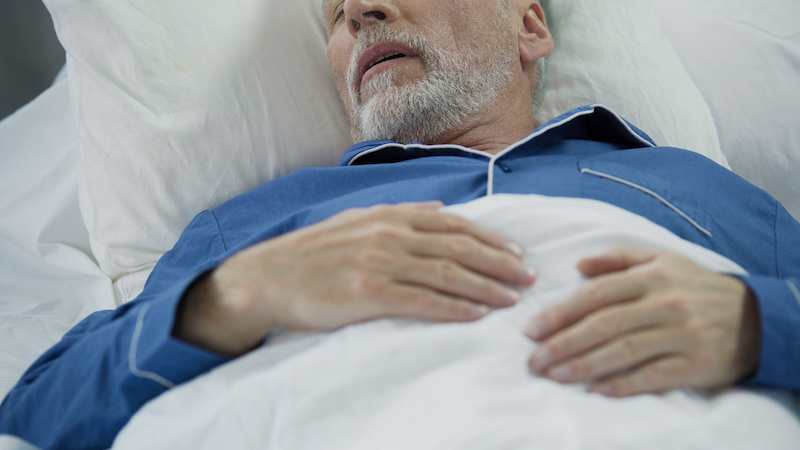Many of us have heard that adults need 7 to 9 hours of sleep each night, and that our bodies go through different stages of a cycle as we sleep. Recognizing sleep apnea in seniors early is crucial to ensure that they receive the important health benefits of deep, sound sleep.
The stage of deep sleep restores energy, increases blood supply to muscles, promotes growth and repair of tissues and bones, and strengthens the immune system.
Sleep apnea—a condition whereby upper airway muscles relax and pinch off the airway and cause a person to quit breathing for up to several seconds—does not allow a person to experience this necessary restorative deep sleep.
Not getting this level of sleep has been linked to Alzheimer’s disease, heart disease, type 2 diabetes and stroke, as well as daytime accidents caused by drowsiness.
Studies have found that sleep apnea causes a spike in blood sugar, heart rate, blood pressure and stress hormones.
It is estimated that sleep apnea affects more than 20 million Americans, yet most remain undiagnosed and untreated.
According to the American Academy of Sleep Medicine, the risk of death is more than two times higher in older adults who have sleep apnea and excessive daytime sleepiness.
Risk Factors of Sleep Apnea in Seniors
The Mayo Clinic lists the following risk factors for sleep apnea:
- Excess weight. Obesity greatly increases the risk of sleep apnea. Fat deposits around your upper airway can obstruct your breathing.
- Neck circumference. People with thicker necks might have narrower airways.
- A narrowed airway. You might have inherited a narrow throat. Tonsils or adenoids also can enlarge and block the airway, particularly in children.
- Being male. Men are two to three times more likely to have sleep apnea than are women. However, women increase their risk if they’re overweight, and their risk also appears to rise after menopause.
- Being older. Sleep apnea occurs significantly more often in older adults.
- Family history. Having family members with sleep apnea might increase your risk.
- Use of alcohol, sedatives or tranquilizers. These substances relax the muscles in your throat, which can make obstructive sleep apnea worse.
- Smoking. Smokers are three times more likely to have obstructive sleep apnea than are people who have never smoked. Smoking can increase the amount of inflammation and fluid retention in the upper airway.
- Nasal congestion. If you have difficulty breathing through your nose — whether from an anatomical problem or allergies — you’re more likely to develop obstructive sleep apnea.
- Medical conditions. Congestive heart failure, high blood pressure, type 2 diabetes and Parkinson’s disease are some of the conditions that may increase the risk of obstructive sleep apnea. Polycystic ovary syndrome, hormonal disorders, prior stroke and chronic lung diseases such as asthma also can increase risk.
Symptoms of Sleep Apnea
If you wake up feeling exhausted, you may have sleep apnea. Other symptoms are mood swings, an inability to concentrate during waking hours, and dry mouth due to the tendency to breathe at night with an open mouth. Some people also awaken with a headache caused by low oxygen or high carbon dioxide levels during sleep. Other symptoms include difficulty staying asleep and irritability.
A bed partner may notice pauses in the breathing patterns of their partner or complain of loud snoring, though snoring is not always an indication of sleep apnea.
Testing and Treatment
If sleep apnea is suspected, a physician may prescribe a sleep study. This is a comprehensive test to diagnose sleep disorders, usually conducted at night at a sleep disorder center or hospital. Called polysomnography, the study will measure breathing rate, oxygen levels, body movements, heart rate and brain waves as a person sleeps.
A continuous positive airway pressure (CPAP) machine is often used to deliver a constant stream of air that keeps airway passages open during sleep. Also, bilevel positive airway pressure (biPAP or bPAP) machines may be more comfortable. These devices deliver more pressure while breathing in and lower pressure when exhaling.
Learn more about living a long, healthy life on Bethesda’s Health & Wellness blog.
| Whether in independent living, assisted living, memory care, or skilled nursing, Bethesda offers the right amenities, services, programming, and staff to make every day full of purpose. See for yourself and tour our independent living communities, including Bethesda Barclay House – Clayton, Bethesda Gardens – Kirkwood, Bethesda Orchard – Webster Groves, Bethesda Terrace – South County, Village North Retirement Community – Florissant, and The Oaks at Bethesda Villas – Kirkwood/Webster. |
Want to find out more?
If you’d like to stay up to date with Bethesda Health Group, sign up here to receive our blog and newsletters!
"*" indicates required fields
Related Articles
Want to find out more?
If you’d like to stay up to date with Bethesda Health Group, sign up here to receive our blog and newsletters!
"*" indicates required fields



